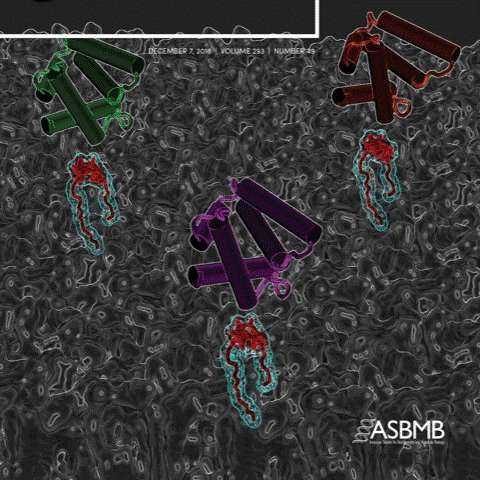Uncovering a key mechanism in assembly of Avian Sarcoma Virus, a 100-year-old oncogenic virus often used to study HIV-1

A key step in retroviral growth inside a cell, as described by Jamil Saad, Ph.D., and colleagues, is portrayed on the cover of The Journal of Biological Chemistry. It is a visual image, in molecular detail, of their journal article inside that looks at avian sarcoma virus, or ASV.
The University of Alabama at Birmingham researchers used nuclear magnetic resonance, or NMR, to detail how the matrix domain of the ASV Gag protein binds to certain phospholipids. These phospholipids are vital for Gag protein binding to the plasma membrane of a cell, as the virus replicates and takes its first step toward virus formation and budding.
ASV, a retrovirus that causes cancer in chickens, is the first oncovirus to have been described, more than a century ago. It belongs to the retroviridae family and is closely related to HIV, the virus that causes AIDS. ASV is widely used as a model to study mechanisms of HIV infection and replication. By studying similarities and differences in replication of the two viruses, researchers learn basic knowledge that can inform efforts aimed to halt replication and spread of HIV. Despite great similarities in their Gag proteins that initiate virus assembly, retroviruses have distinct mechanisms for assembly that are incompletely understood.
The work led by Saad, associate professor of microbiology at UAB, and a companion paper, led by Carol Carter, Ph.D., professor of molecular genetics and microbiology at Stony Brook University, examined how the ASV Gag protein is targeted to the plasma membrane of the host cell to initiate virus assembly. Their findings elucidate the plasma membrane binding by the matrix domain of Gag, all the way from determining the precise molecular shape of the protein domain to studying its vital activity in living cells to initiate viral budding.
At UAB, Saad and colleagues elucidated the molecular determinants of ASV matrix interaction with lipids and membranes, and they provided a model of how the matrix binds to a cell membrane.
Important findings included:
- Obtaining a significantly improved structural model of the matrix domain and identifying a membrane binding site that was not obvious in previously determined structures.
- Providing compelling evidence that a cluster of four lysine amino acids in the matrix domain create a basic surface, which acts as a single binding site that directly interacts with acidic membrane lipids called phosphoinositides.
- Demonstrating that Gag-membrane interaction is governed by charge-charge interactions.
They also show that, although the HIV matrix domain uses more structural tools to bind to the membrane, both ASV and HIV matrix proteins share almost identical interacting motifs that drive assembly.
As part of the UAB experiments, the researchers found that replacing lysine residues in the binding site of matrix with a different amino acid greatly diminished binding to lipids and membranes.
In the companion paper, Carter and colleagues at Stony Brook University used those mutations in the matrix domain of the ASV Gag protein to show that disruption of the phosophoinositide binding site on the matrix domain inhibited Gag localization at the cell periphery in two different cell lines and severely reduced viral particle production, as compared with unmutated ASV.
"These studies solved a longstanding mystery on how a virus discovered a century ago utilizes the plasma membrane of the host cell to replicate," Saad said. "What is even more remarkable is how ASV and HIV-1 share very similar structural features that drive membrane targeting and assembly."
More information: Jiri Vlach et al, Structural basis for targeting avian sarcoma virus Gag polyprotein to the plasma membrane for virus assembly, Journal of Biological Chemistry (2018). DOI: 10.1074/jbc.RA118.003944
Susan M. Watanabe et al. The matrix domain of the Gag protein from avian sarcoma virus contains a PI(4,5)P2-binding site that targets Gag to the cell periphery, Journal of Biological Chemistry (2018). DOI: 10.1074/jbc.RA118.003947
Journal information: Journal of Biological Chemistry
Provided by University of Alabama at Birmingham





















